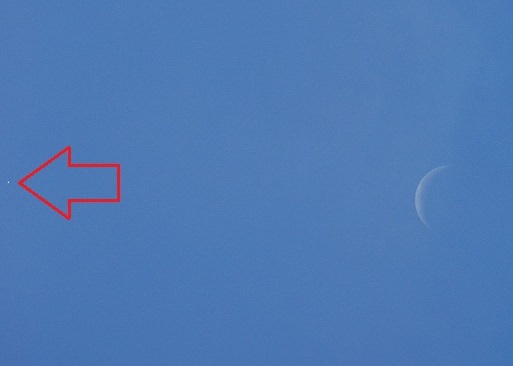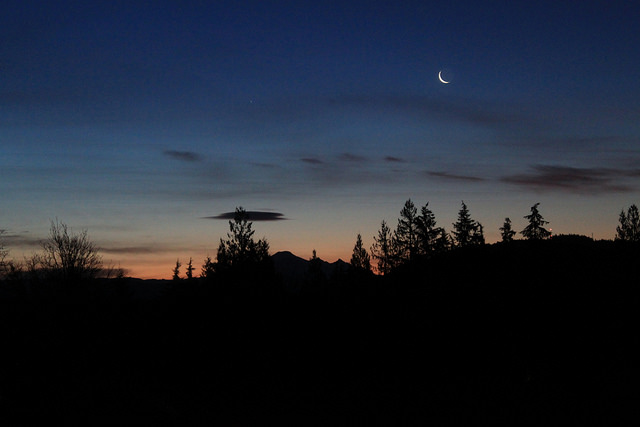Host: Fraser Cain
Guests: Emily Lakdawalla, David Dickinson, Jason Major, Brian Koberlein, Brian Wang
Continue reading “Weekly Space Hangout – January 3, 2014: Quadrantids & What’s Coming in 2014”
Ultra-Thin “Young” Crescent Moon Sighted from U.S. Southwest
Earlier this week, Universe Today challenged North American readers to spot the slender, exceptionally “young” crescent Moon on the evening of New Year’s Day.
Three visual athletes based in Arizona took up the challenge on Wednesday evening, with amazing results. Mike Weasner, Rob Sparks and Jim Cadien managed to spot the razor thin crescent Moon just 13 hours and 48 minutes after it passed New phase earlier on January 1st. The sighting was made using binoculars, and they even managed to image the wisp of a crescent hanging against the desert sky.
This is a difficult feat, even under the best of conditions. Weasner and Sparks observed from Mike’s Cassiopeia observatory based just outside of Oracle, Arizona.
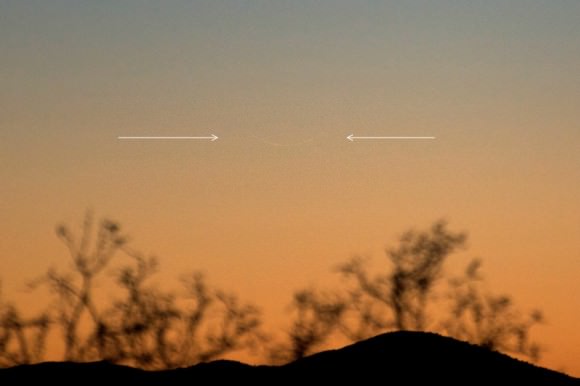
Concerning the feat, Weasner wrote on his observing blog:
“At 1800 Mountain Standard Time (MST), Rob reported that he had located the young Moon using his 8×42 binoculars. At 18:02 MST, I picked it up in the 12×70 binoculars. With the New Moon occurring at 11:14 Universal Time (UT), my observation occurred with the Moon only 13 hours and 48 minutes old. A new record for me (and Rob and Jim as well). Our DSLRs were clicking away!”
We can personally attest to just how hard it is to pick out the uber-thin crescent Moon against the twilight sky. Low contrast is your enemy, making it tough to spot and even tougher to photograph. Add to that a changing twilight sky that alters hue from moment to moment.
Though this isn’t a world record, its close to within about two hours. The youngest confirmed Moon spotting using binoculars stands at 11 hours and 40 minutes accomplished by Mohsen G. Mirsaeed in Iran back in September 7th, 2002, and the youngest Moon sighted with the unaided eye goes to Steven James O’Meara in May 1990, who spotted a 15 hour 32 minute old crescent.
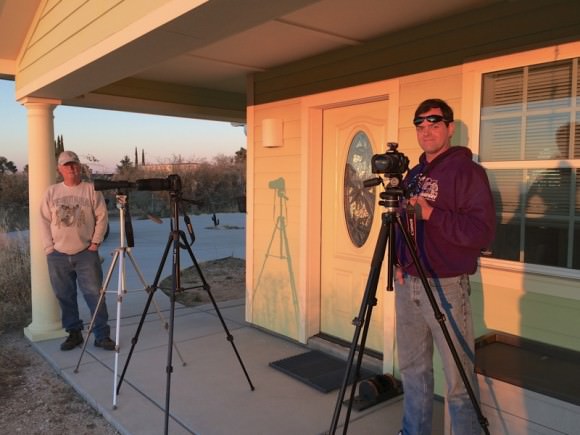
And of course, you can see the Moon at the moment of New during a a solar eclipse. Unfortunately, no total solar eclipses occur in 2014, just an usual non-central annular eclipse brushing Australia and Antarctica on April 29th and a deep 81% partial eclipse crossing North America on October 23rd.
Weasner also noted that a bright Venus aided them in their quest. It’s strange to think that Venus, though visually tiny, is actually intrinsically brighter than the limb of the Moon, owing to its higher albedo. In fact, some great pictures have also been pouring in to Universe Today of Venus as it heads towards inferior conjunction this month on January 11th. And don’t forget, that quoted magnitude of the lunar crescent (about magnitude -3.4) was also scattered along the lunar disk which was only 0.4% illuminated, and subject to atmospheric extinction to boot!
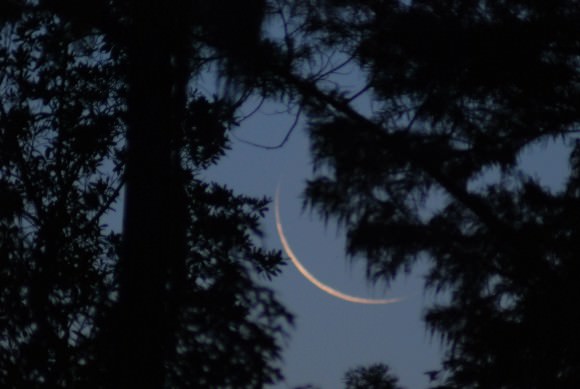
And yes, it is possible to catch the Moon photographically during a non-eclipse at the moment of New phase. The Moon can wander up to 5 degrees – about ten times its average apparent diameter as seen from the Earth – above or below the ecliptic and appear a corresponding distance from the limb of the Sun. Unlike many moons in the solar system, Earth’s moon has a fixed inclination to our orbit (as traced out by the ecliptic,) not our rotational axis. Thierry Legault accomplished this challenging photographic feat last year. Of course, this should only be attempted by seasoned astrophotographers, as aiming a camera near the Sun is not advised.
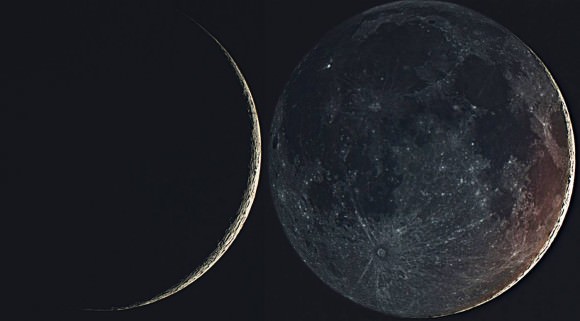
Why attempt to spot the razor thin New Moon? What’s the benefit? Well, several lunar based dating systems, such as the Islamic calendar, rely on the spotting of the new crescent Moon to mark the beginning of a new month. Being strictly lunar-based, the Islamic calendar moves an average of -11 days out of sync each year versus the modern day Gregorian calendar. On some years, there can even be a bit of ambiguity as to exactly when key months such as Ramadan will begin based on when the Moon is first sighted.
Also, such a feat demonstrates what the human eye is capable of when pushed to its physiological limits. In fact, French astrophysicist Andre Danjon theorized that the lunar crescent is formed at about 5 degrees elongation from the Sun, a point beyond which a lunar crescent can be sighted — usually quoted at about 7 degrees elongation from the Sun — and has become known as the Danjon Limit. Danjon also gave his namesake to the characterization of total lunar eclipses by color and hue, known as the Danjon Number. Accounting for the motion of the Moon, this places the theoretical limit that the forming crescent can be sighted with optical assistance at just over 11 hours.
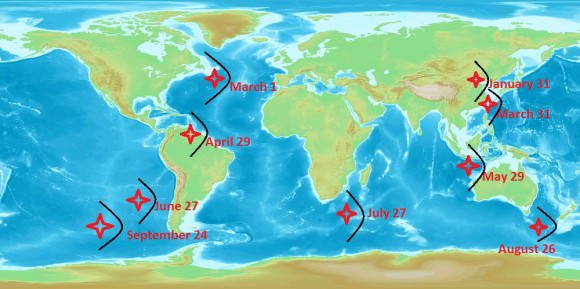
And you don’t have to wait until the Moon passes New… a similar attempt can be made in the dawn skies as the waning crescent Moon slides towards the Sun at the end of each lunation.
But perhaps the true reward is simply catching a glimpse of the ethereal for yourself, a delicate and airy Moon clinging briefly on the horizon. Kudos to Mike and Rob on a great catch!
Follow the further adventures of Mike Weasner and Rob Sparks on Twitter as @mweasner & @halfastro.
Wonder what the sighting opportunities are for the next waxing crescent Moon are worldwide? Two great online resources are the HM Nautical Office’s Einstein Moonwatch Project and Moonsighting.com.
The South African Astronomical Observatory also maintains a site with predictions worldwide.
Now is a Great Time to Try Seeing Venus in the Daytime Sky
Here’s a feat of visual athletics to amaze your friends with this week. During your daily routine, you may have noticed the daytime Moon hanging against the azure blue sky. But did you know that, with careful practice and a little planning, you can see Venus in the broad daylight as well?
This week offers a great chance to try, using the daytime Moon as a guide. We recently wrote about the unique circumstances of this season’s evening apparition of the planet Venus. On Friday, December 6th, Venus will reach a maximum brilliancy of magnitude -4.7, over 16 times brighter than Sirius, the brightest star in the sky. And just one evening prior on Thursday December 5th, the 3-day old crescent Moon passes eight degrees above it, slightly closer together than the span of your palm held at arm’s length.
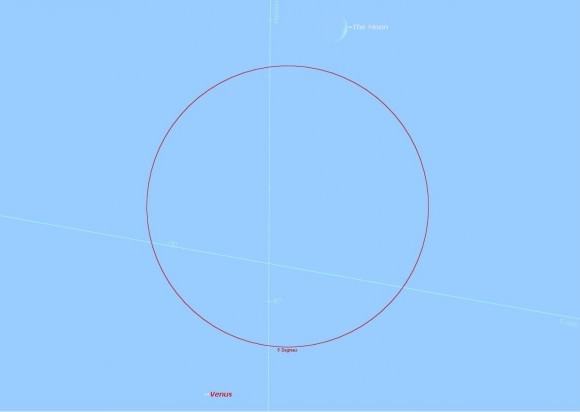
The Moon will thus make an excellent guide to spot Venus in the broad daylight. It’s even possible to nab the pair with a camera, if you can gauge the sky conditions and tweak the manual settings of your DSLR just right.
The best time to attempt this feat on Thursday will be when the pair transits the local meridian due south of your location. Deep in the southern hemisphere, the Moon and Venus will appear to transit to the north. This occurs right around 3:00 PM local. The fingernail Moon will be easy to spot, then simply begin scanning the sky to the south of it with the naked eye or binoculars for the brilliant diamond of Venus. High contrast and blocking the Sun out of view is key — Venus will easily pop right out against a clear deep blue sky, but it may disappear all together against a washed out white background.
The Moon will be at a 10% illuminated phase on Thursday, while Venus presents a slimming crescent at 27% illumination. Though tougher to find, Venus is actually brighter than the Moon in terms of albedo… expand it up to the apparent size of a Full Moon and it would be over four times as bright!
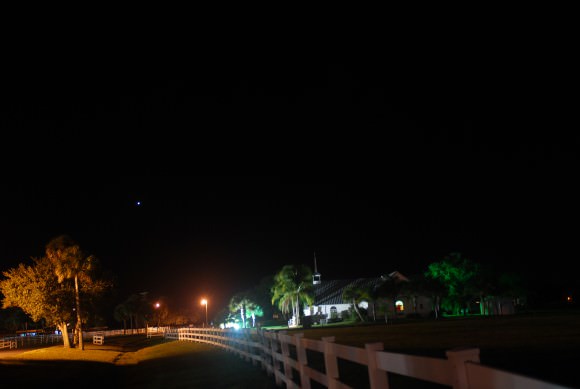
You’ll be amazed what an easy catch Venus is in the daytime once you’ve spotted it — we’ve included views of Venus in the daytime when visible during sidewalk star parties for years.
Due to its brilliancy, Venus has also been implicated in more UFO sightings than any other planet, and even caused the Indian Army to mistake the pair for snooping Chinese drones earlier this year when it was in conjunction with the planet Jupiter. A daytime sighting of the planet Venus near the Moon was almost certainly the “curious star” reported by startled villagers observing from Saint-Denis, France on January 13th, 1589.
Venus can also cast a noticeable shadow near greatest brilliancy, an effect that can be discerned against a fresh snow-covered landscape. Can’t see it? Take a time exposure shot of the ground and you may just be able to tease it out… but hurry, as the waxing Moon will soon be dominating the early evening night sky show!
Another phenomenon to watch for this week on the face of the waxing crescent Moon is known as Earthshine. Can you just make out the dark limb of the Moon? This is caused by the Earth acting as a “mirror” reflecting sunlight back at the nighttime side of the Moon. And don’t forget, China’s Chang’e-3 lander plus rover will be landing on the lunar surface in the Sinus Iridum region later this month on December 14th, the first lunar soft landing since 1976!
The imaginary line of the ecliptic currently bisects the Moon and Venus, as Venus sits at an extreme southern point 2.5 degrees below the ecliptic — in fact, 2013 the farthest south it’s been since 1930 — and the Moon sits over four degrees above the ecliptic this week. The Moon also reached another notable point today, as it reached its most northern “southerly point” for 2013 at a declination of -19.6 degrees. The Moon’s apparent path is headed for a “shallow year” in 2015, after which it’ll begin to slowly widen over its 18.6 year cycle out to a maximum declination range in 2024. It’s a weird but true fact that the motion of the Moon is not fixed to the Earth’s equatorial plane, but to the path of our orbit traced out by the ecliptic, to which its orbit is tilted an average of five degrees.
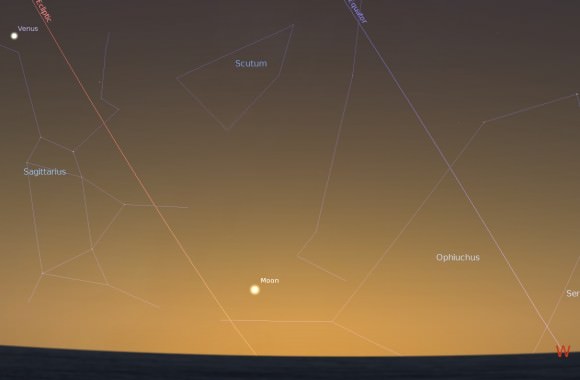
And speaking of the Moon, there’s another fun naked-eye feat you can attempt tonight. At dusk, U.S. East Coast observers might just be able to pick up the razor thin crescent Moon hanging low to the West, only 23 hours past New. Begin scanning the western horizon about 10 minutes after sunset. Can you see it with binoculars? The naked eye? Chances get better for sighting the slim crescent Moon the farther west you go. North American observers will have a chance at a “personal best” during next lunation in the first few days of 2014… more to come!
Be sure to send those Venus-Moon conjunction pics in to Universe Today!
Astrophotos: Crescent Moon, Mercury and Venus Together in the Sky
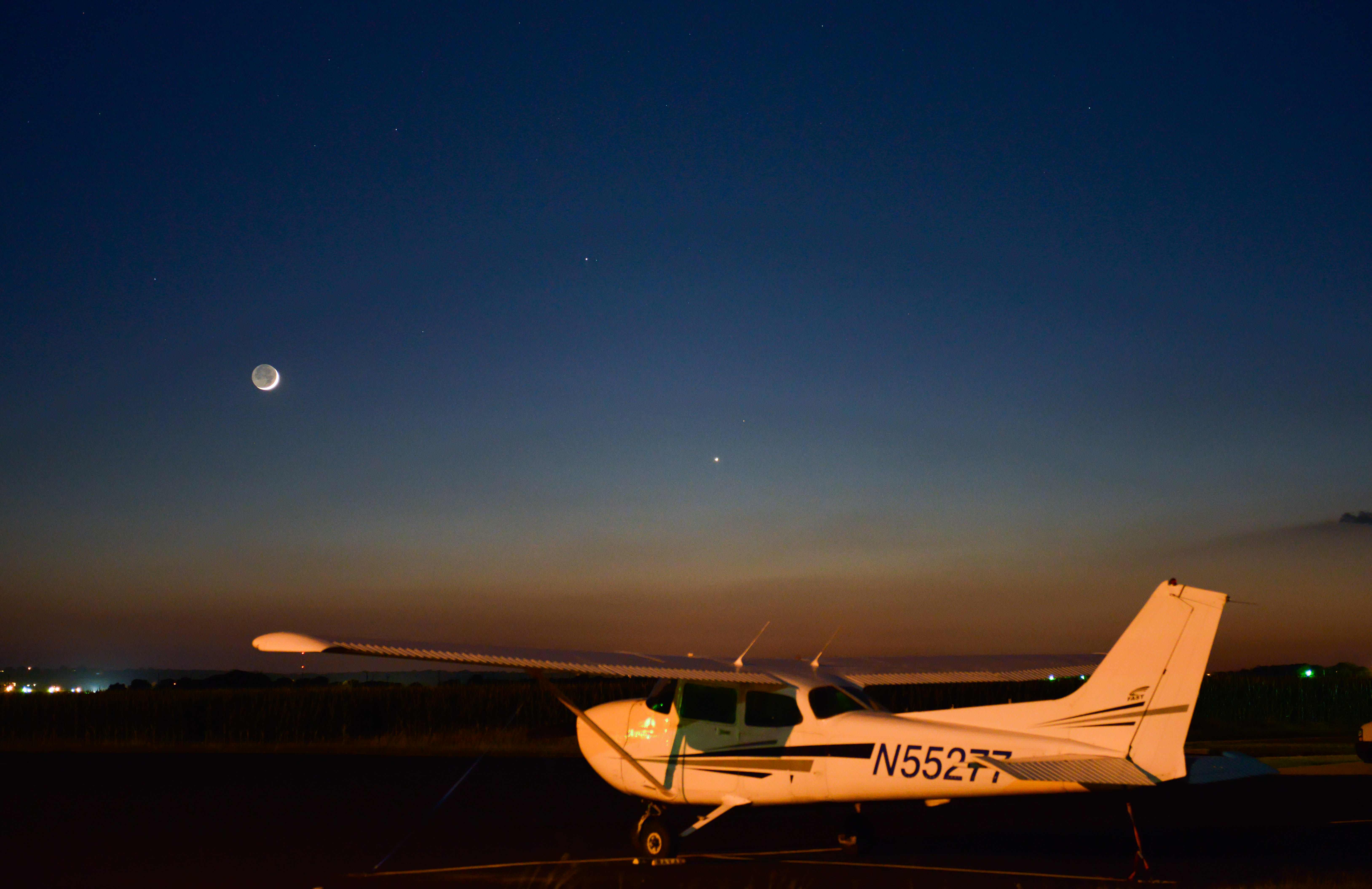
Last night (June 10, 2013) the two innermost worlds of our Solar System visible were joined by a very slender waxing crescent Moon, just over two days after New phase (see our preview of the event here). Several of our readers managed to capture this beautiful twilight triple conjunction. Our lead image is from Adrian New, who went to the Municipal Airport in Castroville, Texas to view the conjunction. “There was a rotating beacon light that would illuminate the planes wing tips at intervals, so I would wait to trip the shutter to capture the effect,” New said via email. This image was taken with a Nikon D800 and a 24-70mm F/2.8 lens set at 70mm @ ISO 2000 and a 1/2 second exposure.
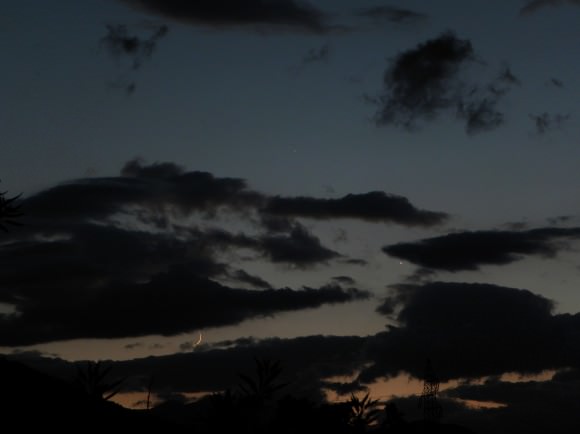
Giuseppe Petricca from the Tuscany region of Italy said he felt lucky to manage to photograph the conjunction, “because the clouds were ‘a bit’ in the way, but also contributed positively to give a nice frame to the whole conjunction.” Giuseppe used a Nikon P90 Bridge digital camera, ISO 100, f5.6, 1/3″. Processed later with Photoshop to increase contrast to enhance the two planets in the sky.
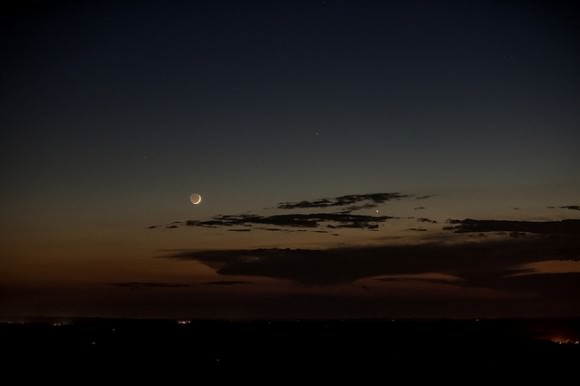
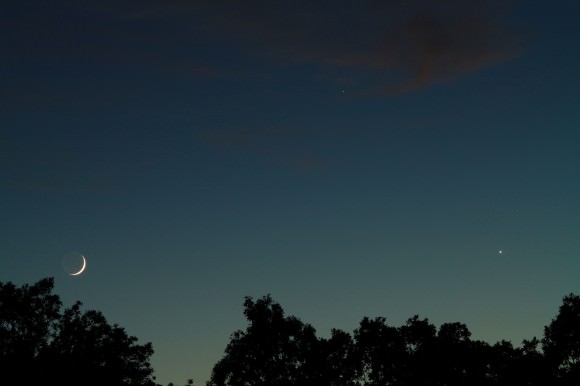
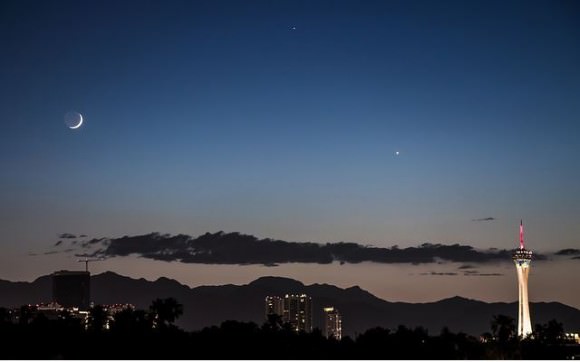
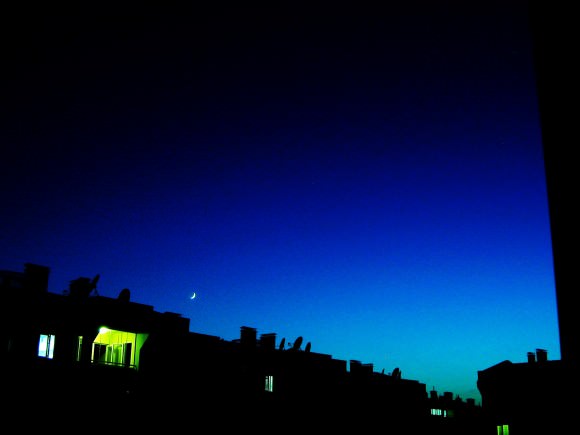
(Canon A40.0, ISO: 50)
Just a reminder to keep looking at sunset for the elusive planet Mercury. As UT writer David Dickinson said in his preview article, if you’ve never seen Mercury, this week is a great time to try.
Catch the Moon pairing with Mercury & Venus Tonight
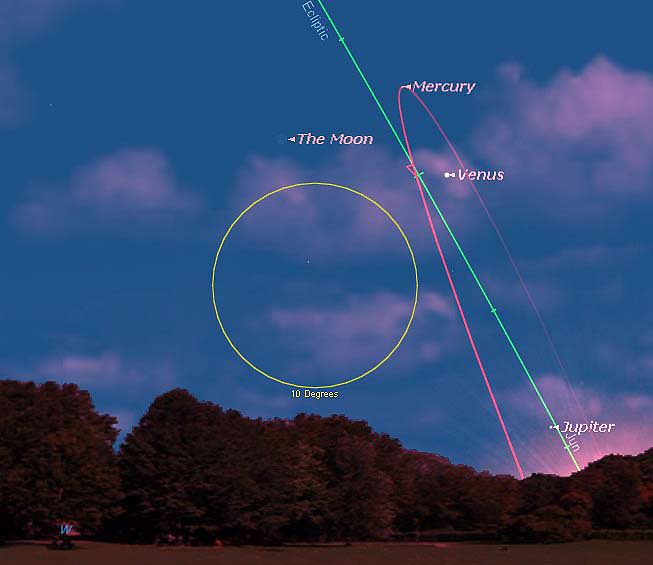
If you’ve never seen Mercury, this week is a great time to try.
Over the past few weeks, observers worldwide have been following the outstanding tight triple conjunction of Mercury, Venus and Jupiter low to the west at dusk.
Jupiter has exited the evening sky, headed for conjunction with the Sun on June 19th. I caught what was probably our last glimpse of Jupiter for the season clinging to the murky horizon through binoculars just last week. If you’re “Jonesin’ for Jove,” you can follow its progress this week through superior conjunction as it transits the Solar Heliospheric Observatory’s LASCO C3 camera.
This leaves the two innermost worlds of our fair solar system visible low to the west at dusk. And tonight, they’re joined by a very slender waxing crescent Moon, just over two days after New phase.
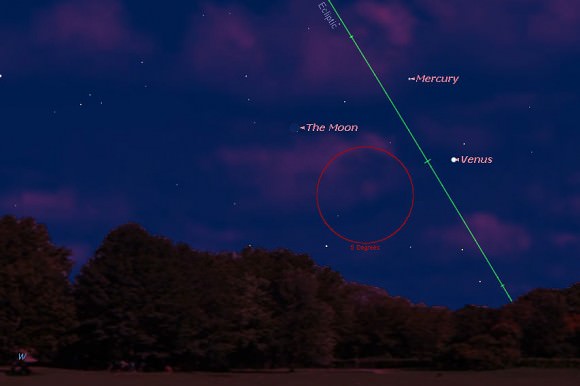
The evening of June 10th finds a 4% illuminated Moon passing just over 5 degrees (about 10 Full Moon diameters) south of Venus and Mercury. Venus will be the first to appear as the sky darkens, shining at magnitude -3.9 and Mercury will shine about 40 times fainter above it at magnitude +0.3.
Ashen light, also known as Earthshine will also be apparent on the darkened limb of the Moon. Another old-time term for this phenomenon is “the Old Moon in the New Moon’s Arms.” Ashen light is caused by sunlight being reflected off of the Earth and illuminating the nighttime Earthward facing portion of the Moon. Just how prominent this effect appears can vary depending on the total amount of cloud cover on the Earth’s Moonward facing side.
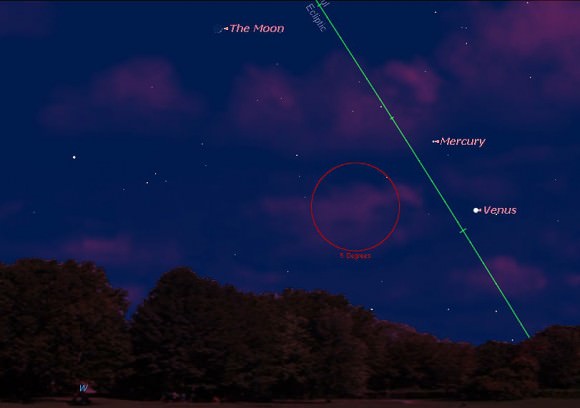
This week sets the stage for the best dusk apparition of Mercury for northern hemisphere viewers in 2013. Orbiting the Sun every 88 Earth days, we see Mercury either favorably placed east of the Sun in the dusk sky or west of the Sun in the dawn sky roughly six times a year. Mercury’s orbit is markedly elliptical, and thus not all apparitions are created the same. An elongation near perihelion, when Mercury is 46 million kilometers from the Sun, can mean its only 17.9 degrees away from the Sun as viewed from the Earth. An elongation near aphelion, 69.8 million kilometers distant, has a maximum angular separation of 27.8 degrees.
This week’s greatest elongation of 24.3 degrees occurs on June 12th. It’s not the most extreme value for 2013, but does have another factor going for it; the angle of the ecliptic. As we approach the solstice of June 21st, the plane of the solar system as traced out by the orbit of the Earth is at a favorable angle relative to the horizon. Thus, an observer from 35 degrees north latitude sees Mercury 18.4 degrees above the horizon at sunset, while an observer at a similar latitude in the southern hemisphere only sees it slightly lower at 16.9 degrees.
Venus and the Moon make great guides to locate Mercury over the next few nights. It’s said that Copernicus himself never saw Mercury with his own eyes, though this oft repeated tale is probably apocryphal.
We also get a shot at a skewed “emoticon conjunction” tonight, not quite a “smiley face” (: as occurred between Jupiter, Venus and the Moon in 2008, but more of a “? :” Stick around until February 13th, 2056 and you’ll see a much tighter version of the same thing! A time exposure of a pass of the International Space Station placed near Mercury and Venus could result in a planetary “meh” conjunction akin to a “/:” Hey, just throwing that obscure challenge out there. Sure, there’s no scientific value to such alignments, except as testimony that the universe may just have a skewed sense of humor…
Through the telescope, Venus currently shows a 10” diameter gibbous phase, while Mercury is only slightly smaller at 8” and is just under half illuminated. No detail can be discerned on either world, as a backyard telescope will give you the same blank view of both worlds that vexed astronomers for centuries. These worlds had to await the dawn of the space age to give up their secrets. NASA’s MESSENGER spacecraft entered a permanent orbit around Mercury in 2011, and continues to return some outstanding science.
Both planets are catching up to us from the far side of their orbits. Mercury will pass within 2 degrees of Venus on June 20th, making for a fine wide field view in binoculars.
And now for the wow factor of what you’re seeing tonight. The Moon just passed apogee on June 9th and is currently about 416,500 kilometers or just over one light second distant. Mercury meanwhile, is 0.86 astronomical units (A.U.), or almost 133 million kilometers, or about 7 light minutes away. Finally, Venus is currently farther away from the Earth than the Sun at 1.59 A.U.s, or about 13.7 light minutes distant.
All this makes for a great show in the dusk skies this week. And yes, lunar apogee just after New sets us up for the closest Full Moon of 2013 (aka the internet sensation known as the “Super Moon”) on June 23rd. More to come on that soon!
Astrophotos: Christmas Crescent Moon from Around the World
[/caption]
A beautiful crescent Moon graced the morning and evening skies over the past holiday weekend, and skywatchers around the world were out with with their cameras! Above, Suraky from British Columbia, Canada took this lovely image of the waning sliver of the Moon from his bedroom window. “The Moon was lit by Earthshine on the dark side, at 7am, with Baker poking out between the trees,” he commented on the image.
See more from other astrophotographers below.
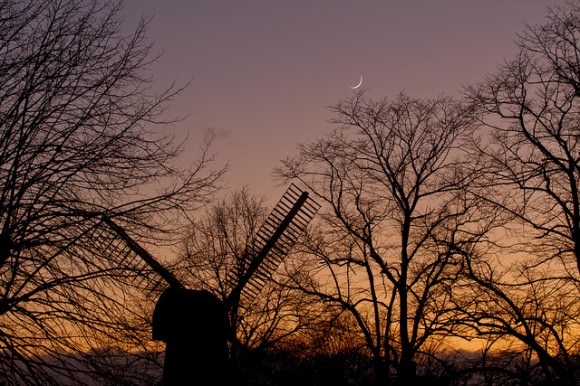
Owen Llewellyn from the UK shared this beautiful shot, taken on Dec. 26, 2011.
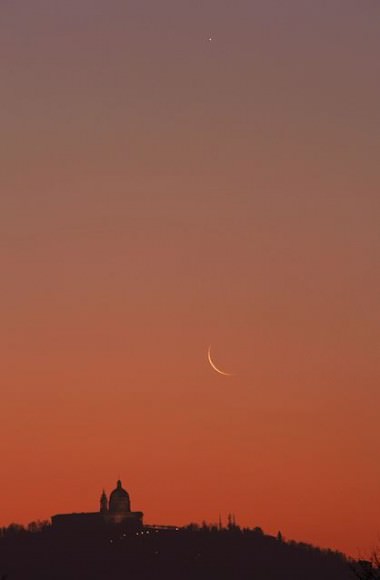
Stefano De Rosa took this image on Dec. 23, 2011 showing the crescent Moon hovering over the Bascilica of Superga in Turin, Italy.
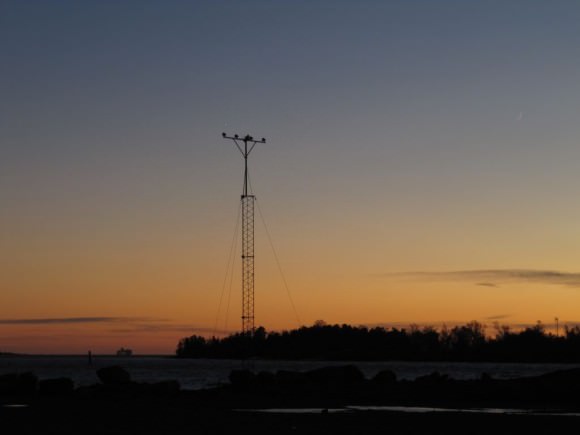
Otto J. Mäkelä from Finland shared this image via Twitter.
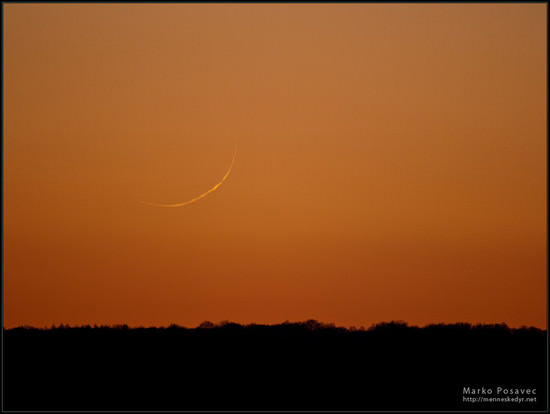
Marko Posavec from Croatia also sent this one via Twitter of a very thin lunar crescent.
Want to get your astrophoto featured on Universe Today? Join our Flickr group, post in our Forum or send us your images by email (this means you’re giving us permission to post them). Please explain what’s in the picture, when you took it, the equipment you used, etc.


